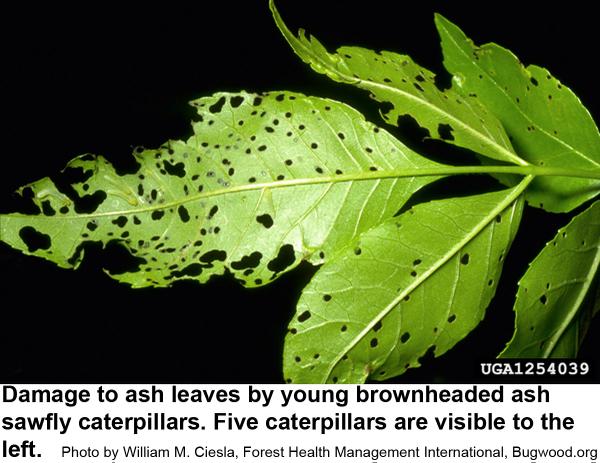Description and Biology
Brownheaded ash sawfly caterpillars, Tomostethus multicinctus, resemble those of butterflies and moths. Full-grown caterpillars are 1/2 to 7/8 inch long, soft, bare, and pale green or yellow-green with white and green stripes down the back. The head is somewhat brown and every segment has a pair of legs. Young caterpillars eat small pinholes. As they get older, they consume entire leaves except the main veins. They are usually fully grown by early June. When mature, these caterpillars drop or crawl to the soil, dig in, spin a cocoon, and spend the rest of the summer, fall and winter there. When abundant, masses of brownheaded ash sawflies congregate aroung the bases of infested ash trees. They pupate in early spring and new adults typically emerge by late April. During warm days, swarms of adults appear around trees to mate and lay eggs. Sawflies somewhat resemble small, dark flies, and they have a sawlike ovipositor used to jab eggs into the the outer margin of young leaflets several eggs per leaflet (hence their name "saw-fly"). We have only one generation per year.
Host Plants
Brownheaded ash sawfly caterpillars sawflies feed on green and white ash trees. It has been reported that ash trees have been stripped bare. Even if that happens, there is only one generation per year, and our long growing season allows spring-defoliated trees to put on a second flush of growth so that little real injury occurs to the health of these trees in the long run. In the short term, defoliated trees may become susceptible to emerald ash borers and other borers in the genus Agrilus.
Residential Recommendations
Fortunately brownheaded ash sawflies are usually not abundant plus they are not resistant to pesticides. Most pesticides labeled for landscape use should give adequate suppression of sawflies. Consider treating only if the insects threaten to remove at least 25 percent of the foliage. To detect potential problems, watch for the pinhole injuries made by the young larvae. If the tree is small enough, a strong jet of water from the hose can knock caterpillars off. Soapy water is effective when applied to the bodies of the larvae. However, Bacillus thuringiensis and neem based insecticides do not appear to be effective.
Other Resources
- Brownheaded Ash Sawfly. Cloyd, R. 2015. Kansas State University Exention Entomology.
- Brownheaded Ash Sawfly – 5.586. Cranshaw, W. S. 2014. Colorado State University Extension.
- Brownheaded ash sawfly. Nixon, P. 2019. Universitu of Illinois Extension, Home, Yard & Garden Pest.
- Extension Plant Pathology Publications and Factsheets
- Horticultural Science Publications
- North Carolina Agricultural Chemicals Manual
For assistance with a specific problem, contact your local N.C. Cooperative Extension center
This Factsheet has not been peer reviewed.
Publication date: May 13, 2019
Reviewed/Revised: Feb. 20, 2024
Recommendations for the use of agricultural chemicals are included in this publication as a convenience to the reader. The use of brand names and any mention or listing of commercial products or services in this publication does not imply endorsement by NC State University or N.C. A&T State University nor discrimination against similar products or services not mentioned. Individuals who use agricultural chemicals are responsible for ensuring that the intended use complies with current regulations and conforms to the product label. Be sure to obtain current information about usage regulations and examine a current product label before applying any chemical. For assistance, contact your local N.C. Cooperative Extension county center.
N.C. Cooperative Extension prohibits discrimination and harassment regardless of age, color, disability, family and marital status, gender identity, national origin, political beliefs, race, religion, sex (including pregnancy), sexual orientation and veteran status.



